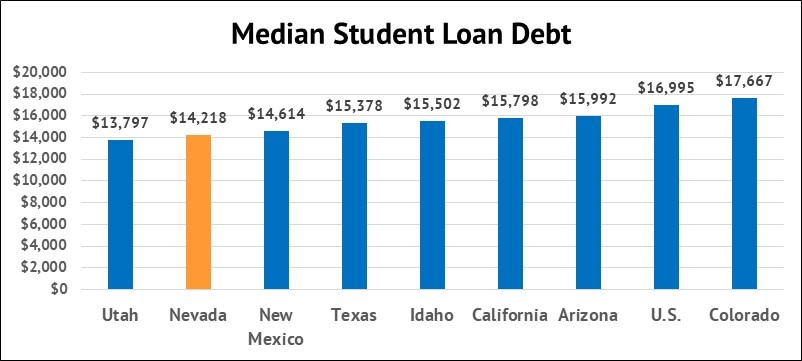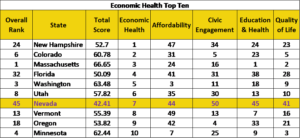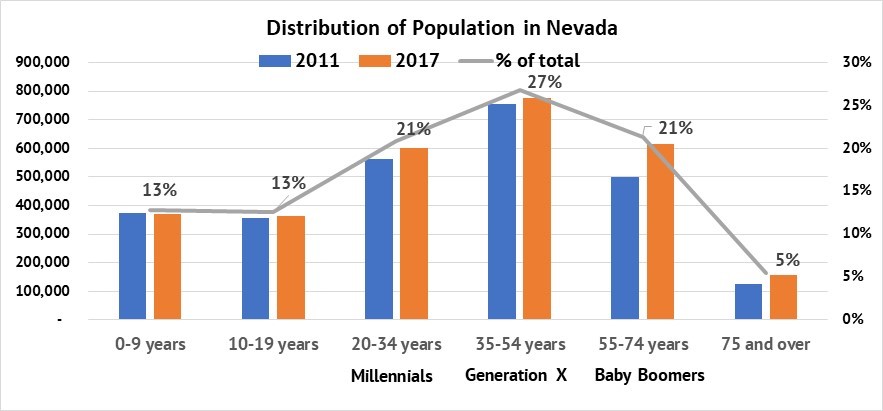by Samuel T. Lair
Recently, WalletHub published a study of 2019’s Best & Worst States for Millennials, a ranking of all 50 states and the District of Columbia to determine the most livable states for Millennials, defined as “individuals who were born between 1981 and 1997.” The study evaluated each area through 36 metrics, grouped into five dimensions of Affordability, Education & Health, Quality of Life, Economic Health, and Civic Engagement.
• Affordability comprises six variables, including the cost of living, average monthly earnings for Millennials, housing cost and home-ownership rate for Millennials, and the annual cost of child care.
• Education & Health comprise 13 variables, including share of millennials with at least a high school diploma, with poor or fair health, with no primary care doctor, and that are insured.
• Quality of Life comprises four variables, including share of millennials, the share of millennials living with their parents, single-friendliness, and family-friendliness.
• Economic Health comprises ten variables, including millennial population growth, unemployment rate, median student-loan debt, average earnings growth for millennials, and the number of entry-level jobs.
• Civic Engagement comprises three variables, millennial voter turnout, millennial volunteer rate, and if the state has a millennial caucus.
Each metric was graded on a scale of 0-100 points, with a score of 100 indicating the most favorable conditions and a score of 0 the least favorable conditions for millennials.
In the study, Nevada ranked 45th overall, with individual dimensions rankings of 44th in Affordability, 45th in Education and Health, 41st in Quality of Life, 7th in Economic Health, and 50th in Civic Engagement. Comparatively, Nevada underperforms among most metrics both nationally and within the Intermountain West Region. As a region, with exception of Utah and Colorado, the Intermountain West generally falls below the national average.
However, on a positive note, both Nevada and the Intermountain West demonstrate strong Economic Health; with three states within the top 10, Colorado (2nd), Utah (6th), and Nevada (7th); and one additional state in the top half, Arizona (18th).
Table 1. Comparing Rankings Among the Intermountain West Region
Nevada’s high Economic Health score likely can be attributed in part to the Silver State’s low unemployment rate, which has fallen steadily since the Great Recession (see Figure 1). Additionally, Nevada scores high marks given that its students have relatively low levels of student debt; Nevada ranks 40th in the country in median student loan debt, which is lower than most Intermountain West states (except Utah) and the national average (see Figure 2).
Figure 1. Unemployment has fallen to pre-Great Recession Levels
Figure 2. Nevada’s Median Student Loan Debt is lower than national average
Nevada’s strong Economic Health rating stands out as an anomaly when compared to the other nine high-ranking states in that category. Nevada, with a grade of 42.41, has the lowest overall grade of all other similarly ranked states in economic health, which boasts an average combined overall grade of 56.56.
Table 2 – Comparing the Top Ten States in Economic Health
A closer look at the data reveals that Nevada’s scores in the categories of Affordability, Education and Health, and Civic Engagement are pulling down its overall ranking. Housing affordability, in particular, is an issue on the minds of many Nevadans. The growing demand for a limited stock of housing and apartments in Nevada’s urban areas, and the resulting steady increase in home prices and rents is affecting Millennials, and everyone else (e.g., workers, low-income families, and seniors). This policy challenge prompted the Nevada Legislature to commission the Interim Committee to Study Issues Regarding Affordable Housing (Senate Concurrent Resolution No. 1, 2017). The Nevada Legislature is currently deliberating more than one dozen bills related to housing and homelessness (see Table 3).
Table 3. Proposed bills that address housing and homelessness
Nevada’s lowest grade is in the category of Civic Engagement. Currently, the Nevada Legislature is considering several bills that could strengthen Millennials’ interest in participating in the democratic process. Among these are bills that would enact same-day voter registration, extended early voting, and increased access to polling locations. Collectively, these measures could help improve Nevada’s standing on the Civic Engagement metric.
Notwithstanding current legislative efforts, addressing some of these issues, such as affordable housing, access to affordable health care, and educational outcomes, will likely require long-term, integrated, and systems-level solutions. If anything, the WalletHub study merely highlights the already well-documented challenges facing Nevada as it continues to grow. While Governor Sisolak’s administration is only 100 days into his term, it will be interesting to see how Nevada fares four years from now.
One in 5 Nevadans is a Millennial
As of 2017, there were approximately 600,000 Millennials in Nevada. As Figure 4 shows, Millennials, as a share of Nevada’s total population, are the third biggest population group in Nevada, accounting for slightly over one-fifth of the population. Generation X-ers (35-54 years of age) make up the largest share of the population with 27 percent, followed by Baby Boomers (55-74 years of age) with 21.4 percent, and Millennials with 20.9 percent. (The U.S. Census Bureau’s age category that most closely aligns with Millennials (ages 22-38 years) is 20-34 years; similarly Generation X is defined as ages 38-53, and Baby Boomers are defined as ages 54-72).
Figure 4. Millennials, as a share of Nevada’s total population, are the third biggest population group
In recent years, Nevada has experienced tremendous population growth. According to the US Census Bureau, five of the ten states with the largest population percent growth from 2017 to 2018 are in the Intermountain West region: Nevada and Idaho (tied for first, 2.1 percent), Utah (3rd, 1.9 percent), Arizona (4th, 1.7 percent), and Colorado (7th, 1.4 percent). From 2011 to 2017 Nevada’s total population grew 8 percent. As Figure 5 indicates, the growth in Baby Boomers (28 percent) and Millennials (21 percent) drove Nevada’s overall population growth over the period 2011-2017.
Figure 5. Millennials are driving Nevada’s recent population growth
In short, data suggests that Millennials account for a significant share of Nevada’s recent population growth. But, as the WalletHub study noted, Millennials face significant challenges in Nevada. Whether they stay and build careers and families here in the Silver State will depend, in part, on how well political and community leaders are able to address some of the complex policy challenges that affect not only Millennials but many of Nevada’s workers and families, including but not limited to housing, quality health care, quality child care, parks and recreation spots, and strong community and civic institutions.







